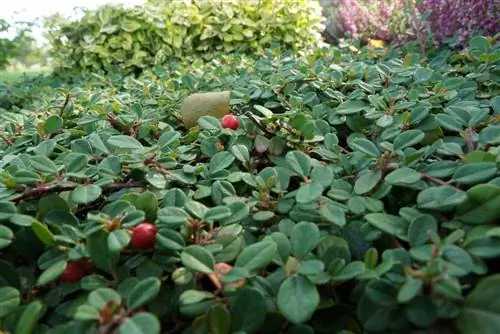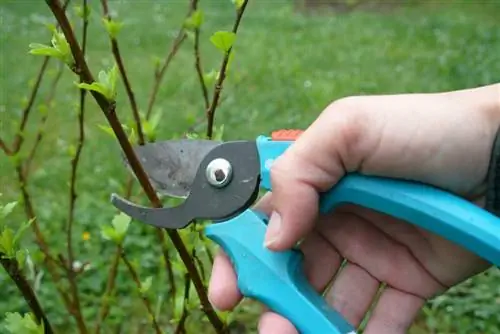- Author admin [email protected].
- Public 2023-12-17 03:39.
- Last modified 2025-01-24 12:45.
Ornamental shrubs are particularly popular with hobby gardeners because they beautify the garden with their loose growth and splendor of flowers. They are comparatively very easy to care for. They are not very susceptible to disease and can usually overwinter outside. A distinction is made between summer and evergreen ornamental shrubs; the best-known types include roses, rhododendrons, jasmine and cherry laurel.
Plants
Spring and autumn are considered suitable seasons for planting ornamental shrubs because the trees are in a dormant state at the beginning or end of the growth phase and grow best. In addition, at this time there is no threat of frost damage and no drying out of the roots due to persistent summer heat. These are the steps to follow when planting:
- first place the bush in a bucket of water so that the roots can soak up
- Dig a sufficiently large planting hole, at least 40 to 50 cm
- Place the ornamental shrub in the hole and fill it halfway with soil
- water the planting hole thoroughly and then fill it full with soil
- Press at the end, but not too hard
Floor
Ornamental shrubs love a loose to crumbly soil structure; compacted soils are unsuitable. The soil should be moist, but waterlogging must be avoided at all costs. If the soil is very dense and clayey, experts recommend mixing the soil with garden soil or replacing it completely with garden soil. Depending on the species, some ornamental shrubs have special preferences:
- Rhododendrons love humus, peat or peat substitute
- Lilac and monkshood like calcareous soils
Location
The majority of ornamental shrubs love sunny or semi-shady locations. However, there are also species that thrive in the shade. When choosing a location, it is also important to consider how frost-hardy the respective trees are. How to choose the right place for your ornamental shrub:
- Cherry laurel originally comes from the Black Sea and is not infinitely frost hardy, it needs a protected location
- Roses feel most comfortable in sunny and airy places, but do not like direct midday sun
- Forsythias love partial shade to sunny
- Lilac likes partial shade to sunny
- Rhododendron also thrives in very shady places, e.g. B. under trees, probably
Wintering
Most ornamental shrubs are considered winter-hardy, and many exotic shrubs can also tolerate a certain amount of frost. In recent years in particular, extremely cold winters with very extended periods of frost have become increasingly common. It is therefore advisable to cover the ground around the bushes with materials such as straw, bark or wood shavings. This also helps against so-called frost desiccation, which many plants suffer from when the soil has dried out due to sun and frost. Some ornamental shrubs require special winter protection, which varies depending on the species:
- For roses, cover the base shoots with spruce branches and pile up the gnarled base with bark mulch
- Shade cherry laurel and rhododendron with netting or garden flow
- Cover the lilac about 20 cm high at the root base with leaves or straw
Fertilizing and watering
Ornamental shrubs are usually fertilized in spring, when the growing season begins and the need for nutrients is greatest. Organic fertilizers and compost are suitable. Work the fertilizer loosely and evenly into the soil. Ornamental shrubs should be watered regularly, making sure the soil is neither too dry nor too wet. More frequent watering is necessary, especially in the hot summer months. To avoid frost-drying in winter, you can water on frost-free days.
Cutting
Most ornamental shrubs require regular pruning, usually every 1 to 2 years, to ensure strong new growth and/or an abundance of flowers and fruits. In order to prevent damage caused by snow loads and wind breakage, certain shrubs can be pruned in autumn, during which weak shoots are removed. However, the actual pruning takes place in February or March on frost-free days. Ornamental shrubs that bloom in summer are radically cut back to approx. 50 cm to 20 cm above the ground, which allows particularly lush new growth to be achieved. Spring-flowering shrubs should only receive one thinning cut in February/March, during which dead, diseased and weak shoots are removed. They are only properly cut back after they have flowered. You should also keep this in mind when cutting ornamental shrubs:
- Species such as magnolias, laburnums and witch hazel only prune in an emergency and only the most urgent shoots, as they have difficulty regenerating
- shorten very long young shoots always about 5 mm above the bud with a slightly oblique cut to keep the wound as small as possible
- Do not repair frost damage until spring, as the extent of the damage only becomes visible after budding
- When removing diseased and frost-damaged shoots, cut deep into the he althy wood
- remove weak shoots up to the base
Pests on ornamental shrubs and their control
- Roses and jasmine are often attacked by aphids, which you can effectively combat with biological sprays
- A typical pest for rhododendrons is the rhododendron cicada, which is attracted to yellow plaques hung in the bush and sticks to them
- Magnolias are often plagued by pests such as whiteflies, but insecticides can help
- Cherry laurel is very susceptible to fungal attack such as powdery mildew and downy mildew, affected leaves must be completely removed
- Laburnum is also susceptible to fungal diseases; affected shoots are cut off at least 15 cm below the diseased area
Conclusion
Most ornamental shrubs thrive very well in our latitudes and are considered an enrichment for the garden with their flowers or fruit decoration. With careful care, the appropriate measures for overwintering and following a few rules when pruning, you can enjoy he althy and lush ornamental shrubs for many years to come.
Care tips
When planting, an ornamental shrub is placed in a bucket of water where its roots are filled with water. While the roots are getting water, a suitable plant hole of around 40 to 50 centimeters in size should be dug for the ornamental shrub, although the soil must be loose.
The ornamental shrub is now placed in the plant hole and the hole is half filled with soil. Now water is poured on it, more soil is added and finally pressed down. Once the transplanting is complete, the ornamental shrub must continue to be watered. Ornamental shrubs should be fertilized in spring with organic fertilizer such as compost, which is loosely incorporated. If weeds appear, it is advisable to remove them by hand or with a shovel, taking care not to damage the ornamental shrub.
Pruning of ornamental shrubs that already bloom in spring is done after flowering. Summer bloomers get their cut in spring, around April. You cut from the inside out and from bottom to top. First you remove dead twigs and branches close to the ground and then trim the inside of the plant. You lighten them up a bit like this; however, only about a quarter of the plant should be removed. The less cutting is done, the fewer wild shoots emerge.
Ornamental shrubs
The ornamental shrubs include firethorn, laurel cherry, gold finger, beautiful fruit, carpet berry, winter blossom, bearded flower, farmer's jasmine, English heather, ornamental cherry, silver bush, Florence magnolia, star magnolia, plate hydrangea, fragrant blossom and others.






